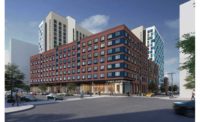One sunny winter day, various L+M Development Partners executives met with ENR at GrandLo, a coffee shop that’s part of a youth jobs training program run by Grand St. Settlement, housed at the 100% affordable housing project Francis Goldin Senior Apartments. It’s the first building L+M did, along with its fellow members of the Delancey Street Associates joint venture, at the massive Essex Crossing cluster of developments on Manhattan’s Lower East Side.
Talk turns to mixed-income housing—L+M’s specialty—versus public housing and other affordable residential projects. But when it’s noted that market-rate tenants might raise a bigger stink about disrepair than would low-income residents, guaranteeing mixed-income buildings’ quality compared with negative public housing scenarios often reported by local news, the firm’s CEO looks aghast.
“No one should have to live like that!” exclaims Ron Moelis, CEO and founding partner of developer L+M, which manages affordable and mixed-income residences long after building them. Then he emphasizes: “Integrated housing is more socially responsible. We shouldn’t be segregating economic classes.” That sentiment is echoed repeatedly by the firm’s other executives. Says chief operating officer Lisa Gomez: “We didn’t want to be in ‘billionaires row.’”
L+M owns three projects on ENR New York’s Top Starts list. Two are at Essex Crossing (it has already built two others with its fellow Delancey Street joint venture members BFC Partners and Taconic Investment Partners; Prusik Group and Goldman Sachs Urban Investment Group are also involved) and one is in Coney Island, Brooklyn—all totaling $660 million. These and other projects, along with L+M’s broader ethos, are reasons for its selection as Owner of the Year.
Looking at L+M’s various developments—mostly in New York City, but also in New Jersey and as far away as New Orleans and San Francisco—a pattern emerges: apartments for low-income tenants, space for community-focused nonprofits and commercial spaces to bring amenities to underserved neighborhoods.
A certain number of residential units are almost always set aside as affordable housing in L+M projects. At all nine of the buildings that comprise Essex Crossing, including L+M's four, 561 of the 1,079 units are affordable (the RFP's requirement was for 500 out of 1000 to be so).
Also at its Essex residences, those who could prove that they or their family members were pushed out of the Lower East Side between 1967 and 1973 were offered the chance to move back. More than 25 families have so far, says Isaac Henderson, L+M’s development director who is managing the firm’s Essex projects.
Nonprofits have a prominent presence in L+M’s major developments, whether it’s the GrandLo; or Per Scholas, an IT training program set to open a branch at the Walker House, the former Bell Building, in Newark, N.J.; or Project EATS, an organization that runs 12 urban farms in all five New York boroughs as well as healthy eating programs for the undernourished.
“When I first started talking to L+M, I was skeptical,” recalls Linda Bryant, founder of Project EATS, which has a half-acre farm on the grounds of the Marcus Garvey Apartments in Brownsville, Brooklyn—an affordable housing project the firm bought in 2014. “I was a filmmaker and ... I’d [covered] gentrification of a black community in Ohio.”
“L+M isn’t just about brick and mortar; it’s also about the people there.”
– Linda Bryant, Founder of Project EATS
Now, Project EATS also runs a youth farmwork training program, a cafe, a greenhouse, free Saturday breakfasts and other programs at the Marcus Garvey site. “I don’t know if we’d have the growth we’ve had without L+M’s partnership,” Bryant says. She adds that while “gentrifiers” she’s documented cared more about property values, “L+M isn’t just about brick and mortar; it’s also about the people there.”
One headline-making community endeavor that will be housed at an L+M site: the Universal Hip Hop Museum, to be built as part of the Bronx Point mixed-use development in the Lower Concourse neighborhood. Phase 1, which is scheduled to break ground in December, will include 540 residential units, all affordable; a waterfront esplanade; and a movie multiplex, the first of its size to open in the borough “in decades,” says L+M senior director Josue Sanchez.
“We tried to pick uses that were somewhat different, and would be a magnet to pull people to the site,” Sanchez says. “A lot of people asked, ‘why isn’t there a hip hop museum’,” considering the borough is nicknamed the Boogie Down for its deep influence on the music genre. “So we did our research and saw … Universal Hip Hop Museum Group had been working for five years” to build one. The museum is slated to open in 2023, according to that group’s website.
While underserved communities might lack proper food stores or other amenities, it’s the opposite at L+M’s Essex Crossing projects. Never mind the new Trader Joe’s. There’s also the Market Line, an underground market where the Lowline underground park was once planned, that will run continuously under three blocks, and a new Essex Street Market just above. The spaces will house vendors from the famed, old Essex Street Market as well as new businesses. Everything from freshly prepared food to fancy beers will be sold, and the market connects to the Regal Cinemas multiplex at 125 Delancey St.
On a recent visit to the retail sites, new industrial kitchen appliances and counters shone in afternoon sunlight. “We moved a ventilation shaft,” Moelis recalls while counting construction challenges that include subways just below the Market Line.
Doug Renna, executive vice president of technical services for TG Nickel, L+M’s contractor for The Essex multi-use project at 125 Delancey, notes other challenges. Enormous transfer trusses had to be set in place to support the concrete tower, requiring two tower cranes to set all the steel. The building is wrapped in a unitized megapanel that is 30 ft long and 9 to 16 ft high that was hard to set while concurrently setting the superstructure, requiring a second workshift.
Luckily, Renna says, because L+M also builds it own projects, the firm understood the contractor’s problems and decision-making process. “We like working for them, frankly,” he says. “They come from our world.”
At the Walker House, which will offer 20% affordable units and 80% market-rate apartments in 440,000 sq ft of space, Jon Cortell, the firm’s vice president for development, recalls that an antenna-like pole “jammed” into the roof by an earlier owner wasn’t waterproofed properly, resulting in damage to offices that “we could not bring back to life.” But another issue—a once open-air Art Deco vestibule, long enclosed until L+M’s renovations, means the lobby restoration will be be more stylish despite extra work. Cortell says the building may help entice people to move to Newark, contributing to the city’s “revival.”
Meanwhile, at the Coney Island affordable, mixed-use housing project on W. 19th St., the city is raising the height of its streets at the same time L+M is building. “The city is telling us you need to put your ground floor 4 ft above the ground,” says development director Spencer Orkus. Flexibility is business as usual for the firm. Cortell touts its ability to vary its “formula” for mixed-use, mixed-income projects in other cities, especially ones like Newark, that aim to grow. He says in locations outside greater New York City, residents can be sheltered from the concept of “people of mixed incomes living together.” Further, the firm has an eye to innovation.
“We’re taking new steps in building types and infrastructure types,” Orkus says. For example, there’s “passive houses,” a new trend in making environmentally friendly buildings “extraordinarily energy efficient—lots of insulation, highly insulated airtight windows,” he explains. In the 1970s, an earlier iteration of the trend resulted in little airflow, poor air quality and mold. Now, not only have builders figured out how to prevent these impacts, they can also promise greatly reduced heating costs—from $200 to $25 per month.
And this appeals not just to environmentalists but also to operators of affordable housing. “Rents often are barely enough to cover operating expenses,” Orkus explains. “With affordable housing, passive houses caught the city’s attention pretty early on.” L+M is working on such a project, the $130-million Sendero Verde apartments in East Harlem.
L+M’s projects are bottom-dollar friendly for other reasons. While typical real estate funding is a combination of debt and equity, lenders may balk at affordable housing. Federal housing credits and New York state housing and brownfield tax credits attract investors who will pay up to 45% of costs. This makes a developer beholden to such investors, incentivizing them to build well and properly manage developments for a long time.
“It’s a great example of public-private partnerships,” Orkus says.
Up in one high-level apartment at 125 Delancey, visitors could see teams busily excavating or erecting at two Essex Crossing sites on one side of the building. At another unit facing the opposite side, laundry is seen hanging atop one of the traditional Lower East Side brick tenement buildings, looking like a scene from the late 1800s. The old neighborhood’s character endures as L+M’s 21st-century structures continue to rise.










